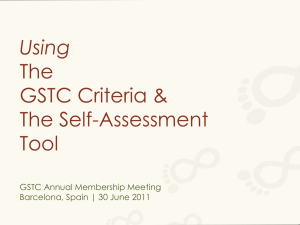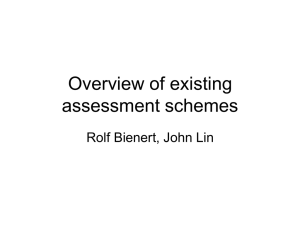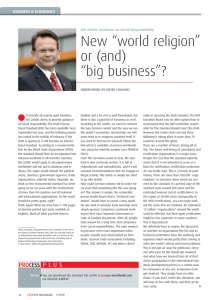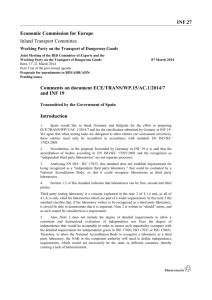How To Become GSTC Accredited - Global Sustainable Tourism
advertisement
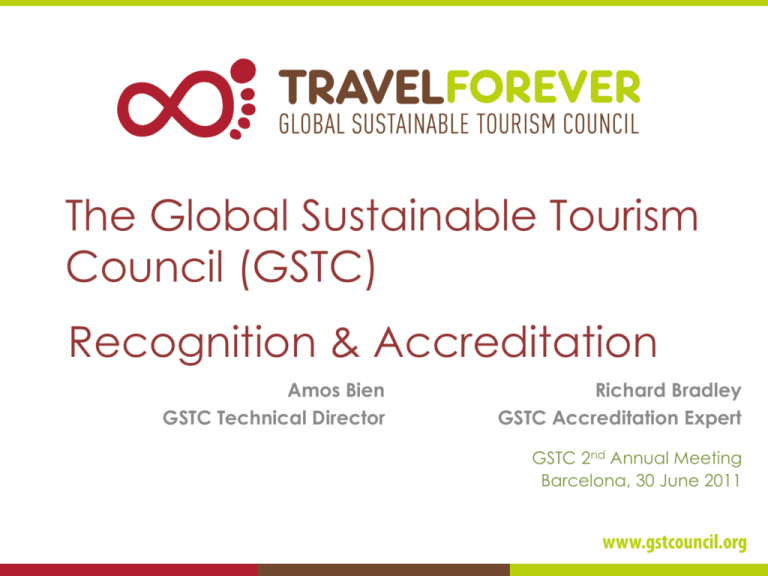
The Global Sustainable Tourism Council (GSTC) Recognition & Accreditation Amos Bien GSTC Technical Director Richard Bradley GSTC Accreditation Expert GSTC 2nd Annual Meeting Barcelona, 30 June 2011 The basics Certification defined • A voluntary procedure by which a facility, product, process, or service is assessed, subject to an audit, and issued a written guarantee stating it meets specific standards. It grants a “marketable” logo to those meeting or exceeding basic standards. Robert Toth 3 Associated activities • Standardization consists of developing a written norm or standard. • Auditing determines whether or not a business or activity meets the standard. • Certification is the process of assessing conformity to a standard and granting recognition. • Accreditation consists of certifying the qualifications of the certifier. • Consultancies prepare companies for their certification. 4 Some characteristics of certification 1. Established Standard All procedures should be clear and in writing. The standard and its component criteria should be welldefined and in writing. The standard should be made available to the general public (although the document may be sold for an accessible price). 2. Voluntary Business participation is voluntary. 3. Credibility Conformity with the standard should be verified by a recognized unbiased entity. 5 Some characteristics of certification 4. Transparency Mechanisms to define standards should be participatory. The certification must be open to all qualified businesses or activities within the scope of the standardConsultancy, auditing, and certifying are independent processes without real or perceived conflicts of interest. 5. It grants a marketing seal or logo Logo use should be controlled by the certifier. Both the certifier and the certified business should use the seal in their promotion. 6. Continuous improvement In order to maintain the certification, a continuous improvement process is desirable, by specification or through different levels (e.g. 1-5 leaves; bronze, silver, gold, etc.). A monitoring and evaluation system should be in place. Businesses should be audited periodically to keep their 6 certification. Limitations on the use of logos • When certifying a service (i.e. a hotel, a tour, or a travel agency), its performance should be assessed. In promoting the product the certification logo can and should be used. • When certifying a process (a management system), such as ISO 9000 or 14001, promoting the service with the certification logo or saying the service is certified is not allowed. 7 Stay in our rooms certified with ISO 14001… Accreditation • Accreditation: third-party attestation related to a conformity assessment body conveying formal demonstration of its competence to carry out specific conformity assessment tasks (ISO/IEC Guide 17011) • Accreditation body: authoritative body that performs accreditation (ISO/IEC Guide 17011) The problems and solutions Confusion in the marketplace 130+ certification labels Little brand recognition or assurance of credibility Most programs are small and have little consumer recognition Number of programs Total = 43 18 Number of certifications Total = 20,963 17 16 8000 7000 14 6000 12 5000 10 8 4000 8 3000 6 5 4 3 2 2 2 2000 3 2 1 0 1000 0 Program size Program size Brand recognition requires years and a critical mass • Blue Flag has certified 3,608 beaches and marinas, and consumers recognize the brand. • Energy Star (USA) has certified millions of products, and consumers recognize the brand. • End-consumer recognition required more than 10 years for these seals. • There were more than13,638 certified tourist businesses in 2007 and 20,963 in 2011, but most labels have few certified businesses. Intermediaries –wholesalers, internet portals, large tour operators– already recognize sustainable tourism certification, but want assurance of credibility and a single language. Certification message and credibility • Message: Certification ensures quality, safety, environmental protection, and corporate social responsibility. • Credibility: The certification standard and processes comply with international and local standards. • Verification of credibility: The standard will be recognized by the GSTC & the processes accredited. • Market penetration: There is a critical mass of certified businesses and message promotion. Problems and solutions Problems Solutions Lack of common understanding of sustainable tourism Global Sustainable Tourism Criteria provide a common operational definition Lack of recognition of standards GSTC recognition of standards aligned with the GSTC Criteria Lack of credibility of certification GSTC accreditation of certification bodies with objectively credible procedures Lack of critical mass for consumer recognition GSTC market access program The details How do we ensure sustainability & credibility? GSTC recognizes credible standards • The Global Sustainable Tourism Council (GSTC) recognizes standards that are aligned with the Global Sustainable Tourism Criteria (GSTC Criteria). • As an interim measure through 2013, the GSTC will award “Working towards Accreditation” (WTA) status to credible certification bodies. • The GSTC will approve accreditation of credible certification bodies. 17 Recognition and accreditation Sustainable tourism standard and conformity assessment scheme Structure, resources and processes • A standard for sustainable tourism enterprises • Processes for updating the standard • Rules for operation (e.g. audit frequency, treatment of nonconformities Certification [conformity assessment] body (CB) Following certification scheme rules for audit bodies, a CB issues certificates to tourism enterprises who conform to certification scheme standards GSTC requirements • The standard must contain equivalent clauses to GSTC’s standard • Rules to update the standard when GSTC’s standard is updated • Rules for conformity assessment structure, resources and processes • Audit body rules must meet minimum GSTC criteria, and any extra rules should not contradict the GSTC’s rules Accreditation requirements • A GSTC approved accreditation body audits each CAB to ensure they meet, at a minimum, GSTC’s CB requirements. • An interim approval as Working Towards Accreditation (WTA) may be granted to “grandfather” existing CBs. If the they meet GSTC requirements, the standard and the conformity assessment scheme are “Recognised” by the GSTC If the CB meets GSTC requirements it is “Accredited” by the accreditation body following GSTC advice. An accredited CAB following a GSTC recognised certification scheme will be licensed to use the GSTC logo Certification meets its own standards • The certification standard chosen by a business should meet the Global Sustainable Tourism Criteria (GSTC). The standard can cover more, but not less. It should be adapted to local conditions and industry sector. • The development of the standard should comply with the ISEAL Code of Good Practice, ISO 59, and TBT Annex 3. • The certification process should follow the international procedures of ISO/IEC Guide 65 (ISO DIS 17065) and the GSTC accreditation procedures. Credibility is thus ensured and market recognition is facilitated. GSTC Manual for Recognition and Accreditation DRAFT PROPOSED RESTRUCTURING OF GSTC ACCREDITATION MANUAL FOR DISCUSSION AND EVALUATION BY ACCREDITATION PANEL AND FOR THE INFORMATION OF THE GSTC BOARD CONTENTS Principal changes: Procedures for recognition of standards are fully separated from those for accreditation INTRODUCTION PART 1 The GSTC Standard for sustainable tourism PART 2 The GSTC GSTC Accreditation CERTIFICATION SCHEME MANUAL Criteria for Certification Bodies PART 3 The GSTC Recognition and Accreditation Procedures “Working towards Accreditation” status and procedures are fully described Note to readers This document is a work in progress. Explanations and comments can be found in call out boxes like this one. Missing information may appear in green highlighter. Requirements for GSTC recognition and accreditation of sustainable tourism certification programs What happened to the title Accreditation Manual? Now we have two stages, recognition and accreditation, it seems that a more generic title is needed. All other programs talk about certification schemes, so that is what is used Version Draft 1.0 Developing the accreditation procedures • Aligned with internationally recognized processes (ISO, ISEAL, IAF, WTO) • Wide consultation (5 workshops – over 100 programs) • Open consultation of manual – 2010 • Manual finalized (version 1) – January 2011 • Recognition of standards initiated – February 2011 • Manual redesigned to address Working towards Accreditation – June-July 2011 The GSTC Recognition & Accreditation Processes Three stage process: 1. GSTC evaluates a standard (certification, verification, 3rd, 2nd, or 1st party) to determine its equivalence with the GSTC Criteria = RECOGNIZED STANDARD http://gstcouncil.org/index.php?option=com_chronocontact&chronoformname=accreditation 2. Working Towards Accreditation (WTA) 3. GSTC, through an ISO 17011-compliant accreditation body, accredits Conformity Assessment Bodies (CABs) that use a Recognized Standard = GSTC ACCREDITED http://www.gstcouncil.org/images/stories/SupportDocs/gstcaccreditation%20manual_16feb11.pdf What Is A Standard? • A technical standard is a “document, established by consensus and approved by a recognized body, that provides, for common and repeated use, rules, guidelines or characteristics for activities or their results, aimed at the achievement of the optimum degree of order in a given context”. - ISO 2 3/ 1 8 GSTC recognition process return Global Sustainable Tourism Criteria 37 criteria, 4 pillars. Sustainability Management Social & Economic Cultural Environmental ISO-IEC Guide 65 (DIS 17065): General requirements for bodies operating product* certification systems • Demonstrated competence of organization and auditors • Legally established independent entity • Impartiality committee • Financial stability • Cannot offer consultancies to certification clients without a major impartiality firewall. * According to the guide, services are “products”. ISO-IEC Guide 67 (17067): Conformity assessment -- Fundamentals of product certification • Describes some of the activities of product certification, • identifies the basic elements and types of product certification, and • demonstrates ways to combine these elements to design a system of product certification. March 18, 2016 Certification of services According to IAF-GD5, Annex 1, to accredit certifiers of services: • The standard should – comply with ISO Guide 7 – or equivalent (e.g. developed with the participation of all interested parties and in consultation with them) – include requirements for performance indicators – include requirements for processes to ensure consistency in the services offered. • Direct observation of the service offered, including “secret shoppers” • Evaluation of internal controls, including processes or management systems Sample logo use Where the GSTC is now • GSTC is evaluating standards for recognition. • GSTC is developing a program for CBs that are working towards accreditation. • GSTC is developing contracts for Accreditation Bodies to accredit the certifiers. • Accredited CBs and their certified businesses will be able to use the GSTC logo and participate in the market access program. • Evaluate the real-world impact of certification. Timeframes Task Estimated start Estimated completion Accreditation manual, version 1 July 2010 January 2011 Accreditation manual, version 2 May 2011 July 2011 Guidelines for recognizing standards November 2010 January 2011 Standards recognition February 2011 ongoing WTA procedures June 2011 July 2011 Contracting & training accreditation bodies Last quarter of 2011 ongoing Awarding WTA status Third quarter of 2011 December 2013 Awarding accreditation First quarter 2012 (earlier for CABs with national accreditation) ongoing One vision we can all embrace. For more information: Global Sustainable Tourism Council GSTCmember@unfoundation.org Amos Bien abien@unfoundation.org We organized the criteria into four actions A. Demonstrate effective sustainable management B. Maximize social and economic benefits to the local community and minimize negative impacts C. Maximize benefits to cultural heritage and minimize negative impacts D. Maximize benefits to the environment and minimize negative impacts. because: • • • • • they require doing something, they are easy to understand, they correspond to the well-known triple bottom-line, but are less ambiguous, the UNWTO 12 Aims can be easily mapped onto them, structure successfully used by a number of modern programs. 33 ISEAL Code of Good Practice Setting Social and Environmental Standards v5.0 June 2010 ISEAL Code of Good Practice for Setting Social and Environmental Standards Based on, in part: ISO/IEC Guide 59:1994. Code of good practice for standardization. ISO/IEC Guide 14024:1999. Environmental labels and declarations - Type 1 environmental labelling - Principles and procedures. WTO Agreement on Technical Barriers to Trade (TBT) Annex 3: Code of good practice for the preparation, adoption and application of standards Differences from ISO The social, environmental and/or economic objectives of a standard shall be clearly and explicitly specified in the standard. Interested parties shall be provided with meaningful opportunities to contribute to the elaboration of a standard. Standard-setting organizations shall identify parties that will be directly affected by the standard and proactively seek their contributions. Constraints on disadvantaged groups to participate effectively in standard development shall be addressed in the standard development process. Final international standards shall be placed in the public domain and, with the exception of reasonable administrative costs, shall be made available for free in electronic format. Particular attention should be paid to the needs of developing countries and small and medium-sized enterprises. ISEAL Code of Good Practice: General Themes Transparency: all activities must be documented, a rationale for decisions provided, and all documentation visible and easily accessible. Inclusion: a diverse group of stakeholders must be actively sought and consulted, especially those parties affected by the standard and including disadvantaged groups with hurdles to participation. Consensus: decisions should be made by consensus. Confidence: Stakeholder engagement and agreement with the process and the outcome must be trusted. Consensus General agreement, characterized by the absence of sustained opposition to substantial issues by any important part of the concerned interests. NOTE – Consensus should be the result of a process seeking to take into account the views of interested parties, particularly those directly affected, and to reconcile any conflicting arguments. It need not imply unanimity. ISEAL Code of Good Practice v5.0, 2010. Advance Documentation Terms of Reference Development Includes a justification of the need for the standard and how it will meet the need Documentation of other similar standards Objectives the standard seeks to achieve Assessment of risks associated with the standard Public Summary & Work Program Brief document explaining the consultation process, the standard being revised, and how to participate Membership requirements/selection criteria for relevant working groups, the Council, and consultation participants are outlines Stakeholder mapping Identify major interest sectors and key interested parties, based on the standard’s objectives. Define: which interest sectors are relevant and why, what are likely to be the key issues for each sector, who are the key stakeholders, what means of communication will best reach them. Include stakeholders with: relevant expertise to the subject matter of the standard, those that are materially affected by the standard and those that could influence the implementation of the standard. Stakeholder outreach Key stakeholders shall be proactively approached to contribute to the consultation. Materially affected parties must make up a meaningful segment of the participants. Constraints on disadvantaged groups to participate effectively in standards development and revision shall be addressed in the standards development process. Public consultation Two rounds lasting no less than 60 days Second round required if there are significant objections and/or inadequate outreach to stakeholders Language requirements should be taken into consideration where possible Interested parties should have “meaningful opportunities to participate” in each part of the process Input should be allowed in a variety of formats and languages The decision making process must be defined and must strive for consensus Each comment must be considered and decision for inclusion or exclusion justified All comments and how they are addressed must be compiled, made public and delivered to all commenters Structure and Content The standard will contain clear objectives that underpin a logical framework A hierarchy of knowledge should be implemented: objective, criteria, indicator, verifier The standard shall allow for monitoring and evaluation towards achievement Language should be unambiguous Expression shall focus on performance rather than design The standard must include and add value to current standards and practices where possible, including attribution or citations where necessary Guidance should be developed for the adaptation of the standard to national, regional, or local levels Organizations with related standards must be informed and included where possible Publication All drafts of the standard should be published promptly and for free Hard copies should be made available on request for as low a cost as possible Translations should be provided where possible Other ISO guides ISO/IEC Guide 2:2004 Standardization and related activities -- General vocabulary ISO/IEC Guide 7:1994 Guidelines for drafting of standards suitable for use for conformity assessment ISO/IEC Guide 14:2003 Purchase information on goods and services intended for consumers ISO/IEC Guide 15:1977 ISO/IEC code of principles on "reference to standards” ISO/IEC Guide 21-1:2005 Regional or national adoption of International Standards and other International Deliverables -- Part 1: Adoption of International Standards ISO/IEC Guide 21-2:2005 Regional or national adoption of International Standards and other International Deliverables -- Part 2: Adoption of International Deliverables other than International Standards ISO/IEC Guide 23:1982 Methods of indicating conformity with standards for third-party certification systems ISO/IEC Guide 28:2004 Conformity assessment -Guidance on a third-party certification system for products 18 de marzo de 2016 ISO Guide 47:1986 Presentation of translations of ISO publications ISO/IEC Guide 50:2002 Safety aspects -Guidelines for child safety ISO/IEC Guide 51:1999 Safety aspects -Guidelines for their inclusion in standards ISO/IEC Guide 53:2005 Conformity assessment -Guidance on the use of an organization's quality management system in product certification ISO/IEC Guide 59:1994 Code of good practice for standardization ISO/IEC Guide 60:2004 Conformity assessment -Code of good practice ISO Guide 64:1997 Guide for the inclusion of environmental aspects in product standards ISO/IEC Guide 68:2002 Arrangements for the recognition and acceptance of conformity assessment results ISO/IEC Guide 71:2001 Guidelines for standards developers to address the needs of older persons and persons with disabilities ISO Guide 72:2001 Guidelines for the justification and development of management system standards Other ISO standards ISO/IEC 17000:2004 Conformity assessment -Vocabulary and general principles ISO/PAS 17001:2005 Conformity assessment -Impartiality -- Principles and requirements ISO/PAS 17002:2004 Conformity assessment -Confidentiality -- Principles and requirements ISO/PAS 17003:2004 Conformity assessment -Complaints and appeals -- Principles and requirements ISO/PAS 17004:2005 Conformity assessment -Disclosure of information -- Principles and requirements ISO/IEC 17011:2004 (Replaces Guide 61) Conformity assessment -- General requirements for accreditation bodies accrediting conformity assessment bodies 18 de marzo de 2016 ISO/IEC 17020:1998 General criteria for the operation of various types of bodies performing inspection ISO/IEC 17024:2003 Conformity assessment -General requirements for bodies operating certification of persons ISO/IEC 17030:2003 Conformity assessment -General requirements for third-party marks of conformity ISO/IEC 17040:2005 Conformity assessment -General requirements for peer assessment of conformity assessment bodies and accreditation bodies ISO/IEC 17050-1:2004 Conformity assessment -Supplier's declaration of conformity -- Part 1: General requirements ISO/IEC 17050-2:2004 Conformity assessment -Supplier's declaration of conformity -- Part 2: Supporting documentation ISO 14024:1999 Environmental labels and declarations -- Type I environmental labelling -Principles and procedures
